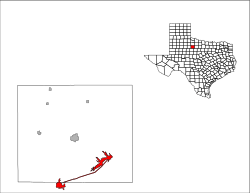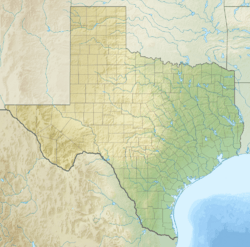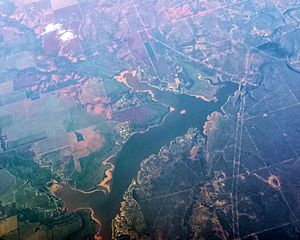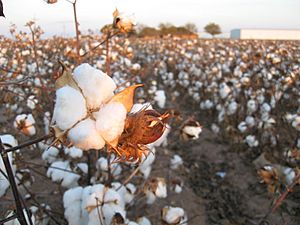Stamford, Texas facts for kids
Quick facts for kids
Stamford, Texas
|
|
|---|---|
| City of Stamford | |

Downtown Stamford
|
|
 |
|
| Country | |
| State | |
| Counties | Jones, Haskell |
| Incorporated (city) | 2 January 1900 |
| Named for | Stamford, Connecticut |
| Government | |
| • Type | Mayor-Council |
| Area | |
| • Total | 12.92 sq mi (33.46 km2) |
| • Land | 5.96 sq mi (15.44 km2) |
| • Water | 6.96 sq mi (18.01 km2) |
| Elevation | 1,450 ft (440 m) |
| Population
(2020)
|
|
| • Total | 2,907 |
| • Density | 225.00/sq mi (86.880/km2) |
| Demonym(s) | Stamfordite |
| Time zone | UTC−6 (Central (CST)) |
| • Summer (DST) | UTC−5 (CDT) |
| ZIP code |
79553
|
| Area code(s) | 325 |
| FIPS code | 48-69980 |
| GNIS feature ID | 2411966 |
Stamford is a city located in west-central Texas, United States. It sits on the border of Jones and Haskell counties. In 2020, about 2,907 people lived there.
The city was named in 1900 by Henry McHarg, who was the president of the Texas Central Railroad. He named it after his hometown, Stamford, Connecticut. Stamford is also famous for being the home of the Texas Cowboy Reunion. You can find Stamford along U.S. Highway 277 and State Highway 6.
Contents
History of Stamford, Texas
Stamford was named by Henry King McHarg, but the land for the town was given by the family of Swante M. Swenson. Swante Magnus Swenson was the first person from Sweden to move to Texas. He became one of the biggest landowners in Texas. By 1860, he owned almost 500,000 acres of land in West Texas.
The Swenson Family and SMS Ranches
These large areas of land became known as the SMS Ranches. Today, the company that runs these ranches, called the Swenson Land and Cattle Company, is still based in Stamford. Swante Swenson's sons, Eric Pierson and Swen Albin, ran the SMS Ranches. They even started a special horse-breeding program near the city.
Swante M. Swenson helped many Swedish immigrants come to Texas starting in 1847. He would help pay for their trip from Sweden to Texas, and in return, they would work for him. In 1899, the Swenson brothers convinced Henry McHarg to build the Texas Central Railroad through their land. The brothers then founded Stamford in 1900 and provided 640 acres for the town. Many of the first people to settle in Stamford were Swedish immigrants. The main street in Stamford is named Swenson, after the family.
Railroad and Early Growth
The railroad arrived in Stamford in 1900. The Texas Central Railway built a 38-mile line from Albany to Stamford. Later, in 1906–1907, another line connected Stamford to Rotan. By 1908, Stamford was connected to other towns north and east by a new railroad line.
Stamford College and World War II
Stamford College opened in September 1907. It was first called Stamford Collegiate Institute. However, due to a drought and World War I, fewer students enrolled. The college closed in 1918 after a fire. The president of Stamford College later started McMurry University in Abilene.
In 1941, the city's airport, Arledge Field, began as a training center for the United States Army Air Corps during World War II. For the first 50 years of the city, a police chief named George G. Flournoy kept order. He was known for practicing target shooting every day outside city hall.
Changes in Railroad Lines
In 1967, the railroad line connecting Stamford to Albany and Waco was no longer used. The line from Stamford to Rotan was bought back by the Texas Central Railway, but it was sold again three years later and then also stopped being used.
Geography of Stamford
Stamford is located in west-central Texas. It is part of the American Southwest and a physical area called the Rolling Plains.
Stamford is about 41 miles north of Abilene. It is also about 132 miles west of Fort Worth and 160 miles west of DFW Airport.
The city covers a total area of about 12.92 square miles. About 5.96 square miles of this is land, and 6.96 square miles, or 53.85%, is covered by water.
Lake Stamford: A Vital Water Source
Lake Stamford is owned by the city and is located about 10 miles northeast of Stamford. This lake was created in 1953 by building a dam on Paint Creek. Lake Stamford provides drinking water for Stamford and several nearby towns. It is also a popular spot for fishing and boating.
Climate in Stamford
Stamford has a semiarid climate. This means it is generally dry. The hottest temperature ever recorded in Stamford was 118°F (48°C) on June 28, 1994. The coldest temperature was -7°F (-22°C) on February 2, 1985.
On average, Stamford gets about 24.7 inches of rain each year. The most snow recorded was 8 inches, which happened on November 25, 2007, and April 6, 1996. Stamford is at the southern edge of Tornado Alley. This means it can experience strong thunderstorms that bring large hail and sometimes tornadoes.
Population and People
Stamford has seen its population change over the years. In 1950, it had its highest population with 5,819 people. By 2020, the population was 2,907.
Who Lives in Stamford?
According to the 2010 census, there were 3,124 people living in Stamford. About 77.1% of the people were White, 8.5% were African American, and 10.1% were from other races. About 32.4% of the population were Hispanic or Latino.
In 2020, the population was 2,907. About 50.36% of the people were White (not Hispanic), and 37.7% were Hispanic or Latino.
Education in Stamford
The city is served by the Stamford Independent School District. Students attend Stamford High School, where their sports teams are called the Bulldogs.
Stamford's Public Library
The Stamford Carnegie Library is a special place. It is one of only four original Carnegie libraries built in Texas that still work as libraries today.
Texas Cowboy Reunion: A Stamford Tradition
The first Texas Cowboy Reunion was held on June 28, 1930. It was created to honor Texas cowboys, keep their traditions alive, and help people feel better during the Great Depression. The first event was a big success, with over 12,000 people watching three days of rodeo events like calf roping and bronco riding.
Rodeo Innovations and Famous Visitors
Will Rogers, a famous entertainer, made one of his last public appearances at the Texas Cowboy Reunion in 1935. In 1937, a record 70,000 visitors came to the event. Stamford helped create new rodeo events, like "double mugging." The popular "cloverleaf pattern" used in barrel racing was also first used in Stamford. In 1940, the American Quarter Horse Association held its first show here. The event became known as the "world's largest amateur rodeo" because most contestants were working cowboys and regular people.
Today's Reunion Events
Today, the Texas Cowboy Reunion is held for four days each year around July 4. It takes place at the Texas Cowboy Reunion Grounds in Stamford. The annual events include a big parade, four rodeo shows, horse races, roping competitions, and chuckwagon cookoffs. There are also Western art shows, fiddling and poetry performances, and dances.
Culture and Entertainment
Elvis Presley's Visits
Elvis Presley, the famous singer, performed at the Roundup Hall on the Texas Cowboy Reunion grounds twice in 1955. His first show was on Friday, April 15, 1955. He also performed at the Stamford High School auditorium earlier that evening. His second show at the Roundup Hall was on Friday, June 17, 1955.
Museum of the West Texas Frontier
The Museum of the West Texas Frontier celebrates the area's history of ranching. It displays original paintings by famous cowboy artists. You can also see old farm tools, antique furniture, and clothing from the past. There is even a chuck wagon, which cowboys used to carry food on cattle drives.
Economy of Stamford
The economy of Stamford mainly relies on education, healthcare, and agriculture.
Many thousands of acres of farmland surround the city. Most of this land is used to grow upland cotton. Stamford has a cotton gin, which separates cotton fibers from seeds. There are also other cotton-related businesses, like a cotton delinting plant and a cottonseed oil mill. A clothing factory and a grain elevator also operate in the city.
Local Media
Newspapers for Stamford Residents
Stamford has two weekly newspapers that keep residents informed:
- The Stamford American
- The Stamford Star
Radio Stations in Stamford
You can listen to these radio stations in Stamford:
- KVRP (AM) 1400 AM "The River" (Christian Contemporary music)
- KLGD 106.9 FM "The Country Giant" (Classic Country music)
Major Highways in Stamford
Notable People from Stamford
Many interesting people have come from Stamford, Texas:
- Noel Brown - A tennis player from the mid-20th century.
- Pete Cole - A former American football player.
- Mike Compton - A former Major League Baseball (MLB) player.
- Charles Coody - A professional golfer.
- Norm Cox - A former American football player.
- Frank Shelby Groner - A former president of the College of Marshall.
- Bob Harrison - A former defensive lineman in the National Football League.
- William C. Holden - The first director of the Museum of Texas Tech University.
- Jeannie C. Riley - A country singer famous for her hit song "Harper Valley PTA".
- James Washington - An NFL wide receiver.
- John V. Roach - An early supporter of the personal computer.
- Robert S. Strauss - An Ambassador to Russia and Special Envoy for the Middle East.
- Charles Stenholm - A former congressman.
- Joe S. Vásquez - A bishop for the Diocese of Austin.
See also
 In Spanish: Stamford (Texas) para niños
In Spanish: Stamford (Texas) para niños





